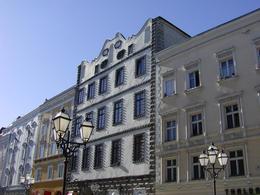Weisz'sches Freihaus Building
Wels, Oberösterreich, Österreich
Stadtplatz 39
4600 Wels
4600 Wels

Weisz's free house
What is a free house: In the Middle Ages and in the early modern times, houses were called “free houses”, which were located within the walls of a town but did not legally belong to it.
Until the middle of the 16th century, Christoph Weiss, whose grandson, Joachim Christoph Weiss, was raised to a “Freiherr” (Freiherr = Landlord, sometimes referred to as "Baron", was part of the titled nobility in the Holy Roman Empire), acquired the object in 1589. That is why it was formerly called "Freiherr Weißes Freihaus". Today it is a passage with shops, restaurants and bars.
What is a free house: In the Middle Ages and in the early modern times, houses were called “free houses”, which were located within the walls of a town but did not legally belong to it.
Until the middle of the 16th century, Christoph Weiss, whose grandson, Joachim Christoph Weiss, was raised to a “Freiherr” (Freiherr = Landlord, sometimes referred to as "Baron", was part of the titled nobility in the Holy Roman Empire), acquired the object in 1589. That is why it was formerly called "Freiherr Weißes Freihaus". Today it is a passage with shops, restaurants and bars.
4600 Wels
Phone +43 7242 67722 - 22
E-Mail info@wels.at
Contact person
Weisz''sches Freihaus
Weisz'sches Freihaus
Stadtplatz 39
4600 Wels
Phone +43 7242 67722 - 22
E-Mail office@wels.at
- Can only be viewed from outside
- All weather
- Suitable for groups
- Suitable for schools
- Pets allowed
- Suitable for teenagers
- Suitable for seniors
- Suitable for single travelers
- Suitable for friends
- Suitable for couples
- Suitable for children
Season
- Spring
- Summer
- Autumn
- Winter
Please get in touch for more information.



